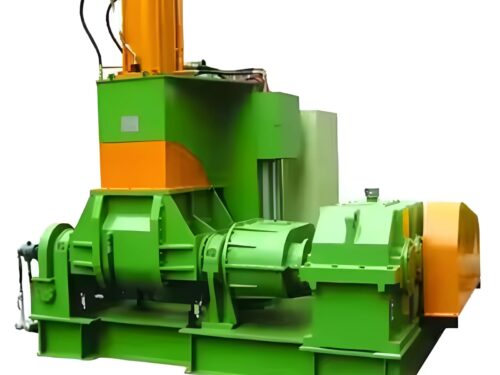What Is an Intermix-Banbury Mixer and How Does It Work?

The Intermix-Banbury Mixer is an intense and heavily efficient industrial machine. It is used not only in the rubber sector but also in the plastic sector. One of the main functions of an Intermix-Banbury Mixer is to combine various materials to create uniform compounds. These uniform compounds are indispensable for producing the widest range of goods, such as tires, consumer goods, and many more. So let’s dive deep into what an Intermix-Banbury Mixer is, how it works, and why it’s very important in modern manufacturing.
What is an Intermix-Banbury Mixer?
An Intermix-Banbury Mixer is a type of specific inner mixer for rubber and plastic compounds. An Intermix-Banbury Mixer was first invented by Fernley H. Banbury in the year 1916, and subsequent versions have been developed -other than the Banbury version, the intermix one- both differing in rotor types and mixing processes and therefore differ in benefits as needed for production.
These mixers are very crucial for achieving uniformity within the compound, which also greatly depends upon the quality of a product. An Intermix-Banbury Mixer typically contains two significant large rotors with multiple blades placed inside a tightly closed chamber in which materials are loaded, mixed, and processed under intense pressure and high temperature. It is very useful for mixing high-viscosity materials, which normal mixers fail to do.
Critical Parts of an Intermix-Banbury Mixer –
The major parts of an Intermix-Banbury Mixer are as follows:
- Rotors: They are the main components of the mixer and are responsible for the kneading and shearing action of the material.
- Mixing Chamber: This is the place in which the actual mixing is carried out. It should be sealed tightly in such a way that material leakage cannot take place.
- Hydraulic Rams: These rams apply some pressure on the material under which its consistency is maintained along with its increased efficiency in the mixing.
- Cooling and Heating System: This system regulates the temperature in the mixing chamber. Temperature is a crucial point in order to process sensitive material.
- Discharge Door: The unit releases the mixed material from the chamber at the end of the cycle.
All of these components harmonize together to present maximum efficiency as well as uniform product.
How Does an Intermix-Banbury Mixer Work?
The Intermix-Banbury Mixer works through several well-coordinated steps to achieve optimal mixing. Here is how the machine does it:
- loading the Materials: In this step, raw materials, including rubber, plastic, fillers, and additives that may comprise the mix, are loaded into the mixing chamber. They are loaded through a hopper or feed chute, depending on the model.
- Compression and Shear: The material is subjected to hydraulic rams, forcing it into the rotors. It begins to turn the rotors, hence bringing up compressive and shearing forces. This is quite important as it helps in breaking down the material into smaller particles while ensuring that everything is well distributed.
- Kneading and Heating: The material is kneaded as the rotors keep turning. Friction causes heating; the temperature has to be maintained constant by a heating system for proper mixing. This step is important more so for higher viscosity systems, as their homogeneity is enhanced.
- Cool down, if necessary: Some compositions require control cooling to avoid decomposition. The cooling mechanism keeps the resultant mixture within the optimal temperature range while avoiding overheating, ensuring that the end product retains the characteristic qualities.
- Discharging: Once the materials have been combined appropriately, the lid of the lid is opened, and the resulting compound is allowed to egress from the cell. It can be harvested as sheets or molded into shape for the desired product, based on the specifications involved.
Advantages of an Intermix-Banbury Mixer –
The use of the Intermix-Banbury Mixer provides many kinds of advantages:
- High efficiency: It cuts the time needed for mixing, thus gaining more output from the production.
- Uniformity: They ensure high-quality products and uniformity in them because high quality and uniformity are necessary for product performance.
- Versatility: It can handle a wide range of materials with varying levels of hardness, from soft to high-viscosity compounds.
- Temperature control: The cooling and heating system also controls temperature better; this is important if the material to be processed easily gets damaged due to its temperature sensitivity.
- Increased Productivity: Labor and energy are conserved because an intermix-banbury mixer has designs that are automated and energy-conserving.
Intermix-Banbury Mixers Application –
Intermix-banbury mixers are used in many industrial firms. The product falls in the following:
- Automotive: it is used to manufacture rubber and tire parts
- Shoe: Used in the production of rubber soles and other parts
- Electronics: applied to manufacturing high-tough plastics-based products.
- General Manufacturing: used in the manufacture of high-quality rubber and plastic materials.
Conclusion –
The Intermix-Banbury mixer is one of the most fundamental necessities to any manufacturing industry, embodying an ideal impression of high efficiency and consistency with versatility in the production of a wide range of materials at incredibly high speeds and pressures, and therefore it is a good powerhouse for any industry that requires uniform compounds, especially automotive, plastics, and electronics. An understanding of its components and operations will enable manufacturers to take full performance with a reflection of product quality and increased productivity.
For More Information Visit Here
https://www.indiamart.com/vatsntecnic/profile.html

 Compression Molding
Compression Molding